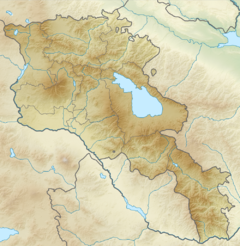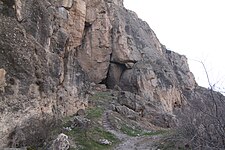Areni-1 cave
| Geographical range | South Caucasus, Armenian Highlands |
|---|---|
| Period | Chalcolithic, Bronze Age |
| Dates | ca. 4,300 — 3,500 B.C.E.[1] |
| Major sites | Areni |
Արենի-1 քարանձավ | |
 Panorama of the site along the Arpa River | |
| Location | Vayots Dzor Province, Armenia |
|---|---|
| Region | Armenian Highlands |
| Coordinates | 39°43′53″N 45°12′13″E / 39.73139°N 45.20361°E |
| Length | 40 m (130 ft)[2] |
| History | |
| Material | Karst |
| History of Armenia |
|---|
 |
| Timeline • Origins • Etymology |
The Areni-1 cave complex (Armenian: Արենիի քարանձավ) is a multicomponent site,[2] and late Chalcolithic/Early Bronze Age ritual site and settlement,[3] located near the Areni village in southern Armenia along the Arpa River.
Findings
[edit]In 2008, Armenian PhD student and archeologist Diana Zardaryan of the country's Institute of Archaeology discovered the earliest known shoe at the site.[4] In January 2011, the earliest known winery in the world was uncovered in the cave.[5] Later, in September 2011, the discovery of a straw skirt dating to 3,900 years BCE was reported.[6] In 2009, the oldest humanoid brain was discovered in the cave.[7] Recent archaeological investigations demonstrate that
The Late Chalcolithic (ca. 4,300–3,500 Cal BC) is represented by the "Areni" and "Godedzor" traditions, with such sites as Areni-1 cave and the settlements of Teghut and Nerkin Godedzor. Society is characterized by a diversity of cultural complexes, growing complexity, relations to the Syro-Mesopotamian (Late Ubaid, Uruk) and North Caucasian (Early Maikop) worlds, as well as extractive copper metallurgy. ... The Late Chalcolithic traditions in Armenia (Areni-1, Teghut, Nerkin Godedzor), Azerbaijan (Ovçular Tepesi, Mentesh Tepe, Leylatepe) and Georgia (Berikldeebi) share common characteristics and regional contacts to Maikop and Ubaid-Uruk. These societies are on the way towards growing complexity, a process reflected in the appearance of developed copper based metallurgy (molds, slags, ingots, kilns, pure and arsenic copper), new metal weapons/tools (knife/daggers, spearheads, flat axes), ceramics (potter's wheel, pottery signs), exotic and prestigious objects of gold, silver, and lapis-lazuli, stamp seals and status symbols (scepters), kurgans and jar burials, and rudiments of monumental architecture (cf. the "temple" of Berikldeebi). This is all accompanied by the blossoming of long distance trade, essential transfer of knowledge, and the development of centralized hierarchies[1]
Genetics
[edit]Three individuals who lived in the Chalcolithic era (c. 5700–6250 years BP), found in the Areni-1 ("Bird's Eye") cave, were identified as belonging to haplogroup L1a. One individual's genome indicated that he had red hair and blue eyes.
Gallery
[edit]-
Chalcolithic leather shoe from Areni-1 cave
-
Entrance to the cave
-
Pathway to the entrance
-
View from the cave
-
The site in 2012, swallow nests on the ceiling of the entrance.
-
Swallow nests 2019
See also
[edit]Notes
[edit]- ^ a b A. Bobokhyan, Kh. Meliksetian, B. Gasparyan, P. Avetisyan, C. Chataigner & E. Pernicka (2014): Transition to Extractive Metallurgy and Social Transformation in Armenia at the End of the Stone Age, p293 and p284 (pdf page 2, 11)
- ^ a b Metheny, Karen Bescherer; Beaudry, Mary C. (7 August 2015). Archaeology of Food: An Encyclopedia. Rowman & Littlefield. ISBN 9780759123663. Retrieved April 10, 2017.
- ^ "Areni-1 Cave, Armenia: A Chalcolithic–Early Bronze Age settlement and ritual site in the southern Caucasus". Research Gate. March 1, 2012. Retrieved April 10, 2017.
- ^ "World's oldest leather shoe found in Armenian cave". Reuters. Archived from the original on May 25, 2019. Retrieved May 25, 2019.
- ^ Owen, James. "Earliest Known Winery Found in Armenian Cave." National Geographic. January 10, 2011. Retrieved January 14, 2011.
- ^ "5,900-year-old women's skirt discovered in Armenian cave". News Armenia. September 13, 2011. Retrieved September 14, 2011.
- ^ Bower, Bruce (12 January 2009). "Armenian cave yields ancient human brain". ScienceNews.







